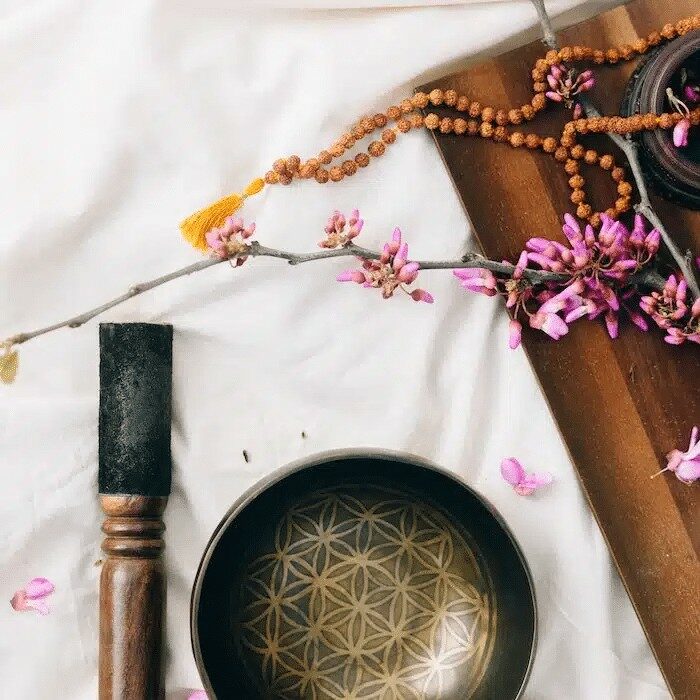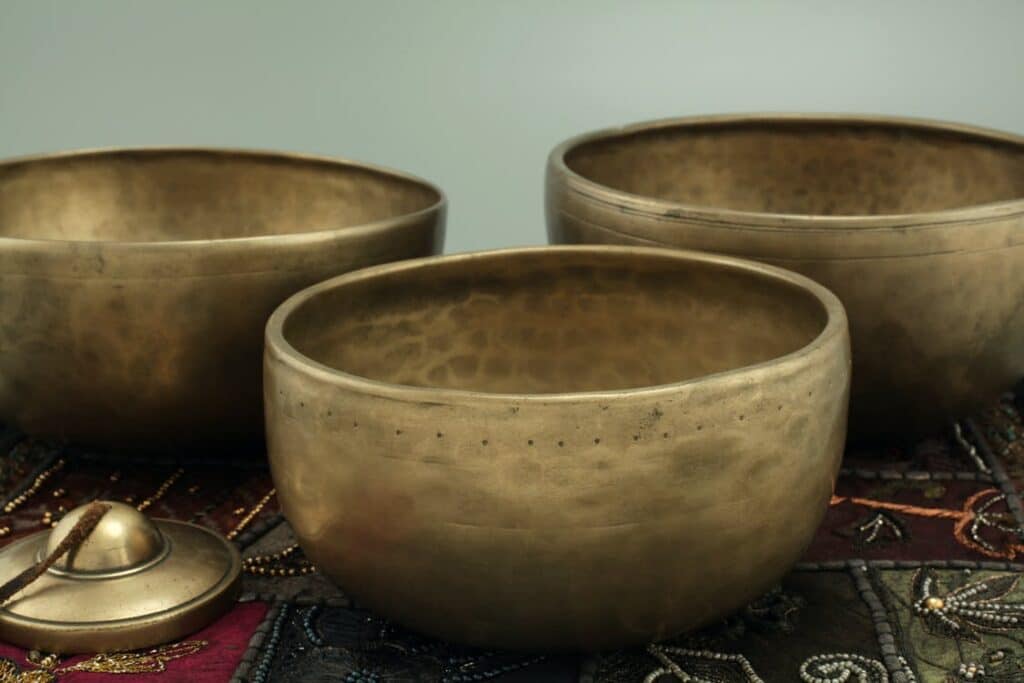Meditation Singing Bowl Tibetan — A Comprehensive Guide for Beginners
Everything is in a constant state of unrest — or vibration from the smallest atom to the giant sun. Since “everything” includes the human body, we have the capacity “in theory” to alter our bodies through vibration.

What is a Singing Bowl
The Tibetan singing bowl. This unassuming object is more than your typical kitchen utensil. The rich history of Buddhist bowls dates back to ancient Mesopotamia 5,000 years ago.
The practice of using Tibetan singing bowls for meditation and religious practice spread to Tibet, Nepal, and India over the last 2,000 years. They are widely known as Tibetan singing bowls due to refugees trading goods they found in Nepal.
How do you Activate a Singing Bowl?
To make the meditation bowl sing, you need to hit it with a mallet or striker. Looking at the bowl sideways, you’ll notice a bulge. Apply a soft tap on that spot, then proceed to rim the bowl in a circular motion along the outermost part to create a continuous sound.
The corresponding striker is usually added when you buy a Tibetan singing bowl. You can also use different materials for the mallets, including a stick with a padded half. The rule of thumb is that the bigger the singing bowl, the larger the striker you need.
Large Himalayan bowls have a lower tonal vibration. You will need a bigger striker to produce a rich sound. While hitting a meditation bowl with the handle will create a sharper sound.
A cushion o-ring is placed below the meditation bowl to keep it from slipping. Also, the cushion acts as a barrier between the singing bowl and whatever you place it on. Without the cushion ring, you will make a discordant sound when playing the singing bowl on a hard surface.
You can also play while holding the singing bowl with your hands. However, you will need to carry it with an open palm and refrain from grasping it too hard. Clamping it too hard with your fingers will dampen the vibration making it harder to play.
Tibetan Singing Bowls Benefit
Himalayan bowls were popular ceremonial objects during Buddhist temple service. But in addition to meditation, they were used as an instrument to improve blood circulation and overall body pain relief back when modern medicine was non-existent.
Present-day singing bowl sessions focus on stress relief and creating an ambiance for other meditation routines like yoga classes. You will usually hear meditation bowls in yoga studios and other spiritual practices.
There are even observational studies showing the effect of using singing bowl sound therapy in improving mood, lessening pain, and boosting the overall well-being of practitioners.
Using Tibetan Singing Bowls for Healing
You can use Tibetan bowls by positioning them on the affected part of your body that needs treatment or relief. Afterward, strike the bowl in a sequence to create the desired vibrations.
The vibration produced by the Tibetan singing bowls may alleviate pain like headaches if placed on the head. Additionally, the soothing vibration that permeates the body may provide mental and emotional relief.
Nowadays, a good night’s rest can often be the most valuable commodity. Sleep meditation using Himalayan bowls can help relieve anxiety and depression, give you much-needed sleep, cure insomnia, and boost your health.
Some studies claim that sound therapy bolsters your body’s immune system. The good vibrations create changes in the brain waves, stimulating your immune system. Centering and unblocking the flow of life energy in your body.
Buddhist bowls’ healing properties may be a good alternative to modern medicine. Its main purpose is to boost your body’s ability to heal naturally. This technique promotes general awareness of natural healing processes like Naturopathy.
Please be advised that there is no clear scientific evidence of the effects of meditation bowls. Even so, there is considerable anecdotal evidence as well as research studies that support sound therapy having a positive impact on the mind, body, and emotions.
Tibetan Singing Bowl Composition
A Buddhist bowl amalgamated of five to seven different metal alloys. These precious metals are copper, mercury, iron, tin, lead, gold, and silver. The seven elements correspond to the seven different chakra points of the human body.
Himalayan bowls come in a wide variety of sizes. Lingam, Remuna, Manipuri, Mani, Naga, Ultabati, Jambati, and Thadobati are the different kinds of meditation bowls. There are also two types of singing bowls: crystal and metal.
The bowls’ Sanskrit names came from the affected location of chakra points. The flow of energy came from the root or the end of the spine rising upwards passing the stomach, neck, chest, and ends in the forehead.
The purpose of the differently-sized bowls is to produce a wide range of vibrations. The frequencies are proportional to the body starting from the root. With higher vibrations affecting the Third-eye and the Crown chakra points.
Hand-hammered vs. Machine-made Singing Bowls
Merchants selling Himalayan bowls will usually display both machine-made and hand-hammered bowls.
Hand-hammered Himalayan bowls have different layered metals. This creates rich overtones that you can liken to a congregation of monks chanting Om Mani Padme Hum. Handmade Buddhist bowls have an uneven bowl edge and distinct overlapping layers.
On the other hand, machine-made meditation bowls produce a distinct, clear yet unchanging tone. They have a uniform design and appearance. Machine-made Buddhist bowls have clear tones, but the vibration fades away quicker than the handmade meditation bowl.
Crystal vs. Metal Singing Bowls
First, the main difference between crystal and metal bowls is in the materials. Crystal meditation bowls are composed of super-heated quartz molded into a bowl shape. Metal meditation bowls are created by hammering layers of metal sheets.
Practitioners in the 1990s were using crystal meditation bowls as healing tools. crystal meditation bowls create bowls with complex vibrations, crystal meditation bowls create a more singular tone.
Looking for the best brands of crystal singing bowls is an ongoing process but frosted bowls are the sturdiest. In addition, clear quartz crystal bowls can hold a tone for a long time.
Advanced users can create a beautiful blending of sound and vibration using crystal singing bowls. The sustained oscillations allow the music therapist to perform chakra healing by playing multiple crystal bowls.
Tibetan Singing Bowls for Sale
The increasing popularity of Himalayan bowls in the west leads to affordable bowls. Machine-made bowls are cheaper and easily mass-produced than handmade bowls. The more expensive bowls are the antique bowls that are still in circulation.
You can easily purchase meditation bowls from online retailers or your local exotic goods market. Just make sure to properly test the product when buying locally or read reviews before buying online.
Although familiar Google searches often refer to the seven precious metal alloys. Contemporary metal meditation bowls today are only using five metals without gold and silver.
However, antique Buddhist bowls are still in circulation if you want more genuine seven-alloyed products. They are rather costly though and are sought-after by collectors.
The metal singing bowl is easier to use, making it helpful for beginners. In addition to being breakable, crystal bowls don’t have the multiple overtones that metal bowls have, which is essential for sound exploration.
In Conclusion
The Himalayan bowl is becoming more popular in the west due to mainstream media. The most prominent Tibetan singing bowl benefit is the embracement of eastern culture. Meditation bowls became household items for religious, decorative, and practical uses.
Buddhist bowls’ most incredible gift to humanity is to enlighten and make us understand the value of cultivating our spiritual health and not only material possessions.
Tibetan singing bowls are certainly more than a religious item, decoration, or hobby. They are also instruments linking us to nature and the universe.
“If you want to find the secrets of the universe, think in terms of energy, frequency, and vibration.” — Sir Nikola Tesla.
Frequently Asked Questions
Can using a Tibetan singing bowl cleanse
The meditation bowl’s vibrations affect the brain waves. This induces the body to relax and go into a euphoric state, like listening to music. Exposure to healing vibrations from Buddhist bowls may improve our body’s ability to self-heal.
Are singing bowls evil?
The sound from a Tibetan singing bowl symbolizes the Om Chant, which Buddhists and Hindus consider the sacred sound of the universe. The overall spiritual fulfillment and health improvement are the total opposite of being evil.
What brand of singing bowl has the best sound?
The simple answer is that there is no perfect singing bowl in terms of sound. All the styles of Buddhist bowls are equally important. The effectiveness depends on how you use them.





